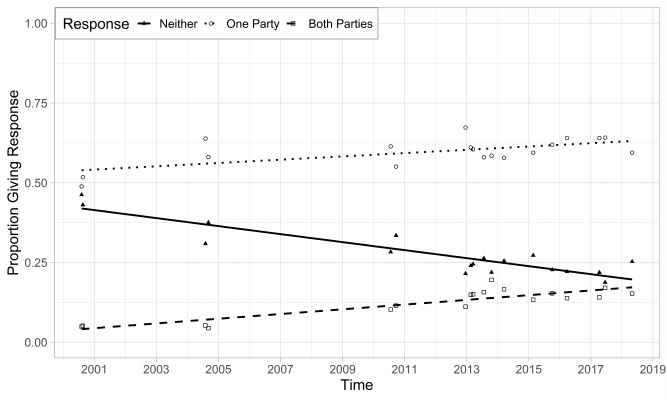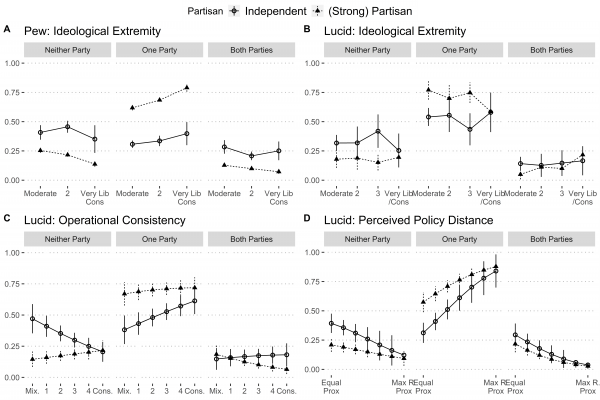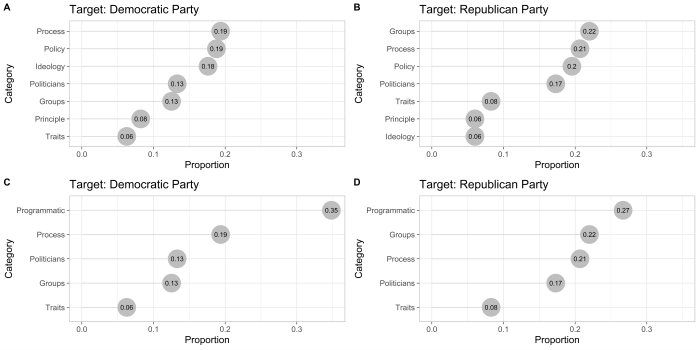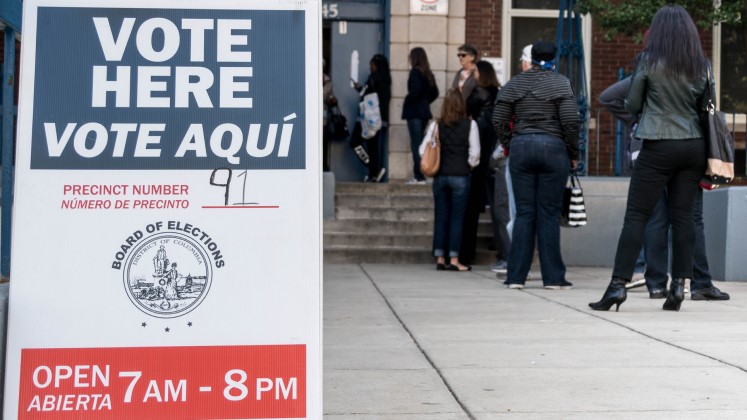 An apparent deepening in the polarization of American politics has encouraged researchers to consider whether the Democratic and Republican parties are too extreme for the political tastes of a population who consider largely consider themselves to be moderate. Using national surveys on American perception of the two main parties Joshua Robison explores this question, finding that even as more Americans have started to view both parties as too extreme, most still only consider the party they don’t support as extreme. A lack of public knowledge about parties’ political and ideological positions, he writes, means that party elites can continue to push for measures that “moderates” consider extreme without great pushback from the electorate.
An apparent deepening in the polarization of American politics has encouraged researchers to consider whether the Democratic and Republican parties are too extreme for the political tastes of a population who consider largely consider themselves to be moderate. Using national surveys on American perception of the two main parties Joshua Robison explores this question, finding that even as more Americans have started to view both parties as too extreme, most still only consider the party they don’t support as extreme. A lack of public knowledge about parties’ political and ideological positions, he writes, means that party elites can continue to push for measures that “moderates” consider extreme without great pushback from the electorate.
There is a growing worry in the research on US politics about whether the choices offered by the Democratic and Republican parties are too extreme for the mass public. After all, most ordinary Americans are ideologically moderate even in a time when party elites have grown increasingly far apart ideologically. This creates a puzzle: why hasn’t the moderate public reined in a party system that is growing increasingly extreme?
In new work, I argue that one answer to this puzzle concerns how ordinary people form perceptions about whether a political party is “too extreme”. On the one hand, most Americans possess partisan identities that motivate them to form one-sided interpretations of party extremity wherein only one party, the one they don’t support, is too extreme. I argue that this will occur even among ideological moderates and those caught in the middle between polarizing party elites. On the other hand, I argue that it is likely that many Americans will associate “extremity” with non-policy and non-ideological considerations that are unlikely to neatly respond to growing ideological divisions between elite partisans.
More Americans think both parties are too extreme…but most don’t
I examined the American public’s perceptions of party extremity using data from eighteen national surveys conducted from 2000 through 2018 wherein respondents were asked whether the Democratic and/or Republican party was “too extreme” or not. I supplemented this large collection of data with a national survey of my own conducted in April 2019 where respondents were asked these same questions as well as for their reasons for labeling a given party as “too extreme”.
I began by categorizing respondents into three groups: (1) those that said neither party was too extreme, (2) those that said one party was too extreme, and (3) those that said both parties were too extreme. Figure 1 shows the proportion of Americans falling into each group across time.
Figure 1 – More Americans Say Both Parties are Too Extreme, but Most Just Say One Is

My first notable finding is that there has been a marked increase in the percentage of Americans saying both parties are too extreme with ideological moderates driving this increase over time. However, this group remains a minority, as most Americans continue to think that only one party is too extreme.
I then examined the interaction between partisan identification and ideology using a variety of measures of ideological attitudes. Figure 2 provides the key results by showing the probability that a respondent falls into each category depending on whether they are a pure Independent (empty circles) or a strong partisan (triangle). The x-axis in each figure indicates something about the respondent’s ideology: whether they say they are a moderate or an extremist (top figures), whether their issue attitudes are ideologically consistent (bottom left), and whether the respondent is ideologically closer to one party than the other (from equally close to both to maximally closer to one rather than the other).
Figure 2 – Partisanship Conditions the Influence of Ideology

The key finding shown in Figure 2 is that the relationship between ideology and extremity perceptions depends critically on partisan identification. Ideological moderates — those with mixed issue attitudes, and those that are equally distant from both parties — are more likely to say that “one party” is too extreme, and less likely to say that “both parties” are too extreme when they are partisans rather than Independents. Partisanship acts as a type of ‘brake’ on believing that US party system as a whole has grown too extreme.
What does “extreme” mean?
What do people mean when they say that a political party is “too extreme”? One natural answer is that people have beliefs about the specific policy positions and ideological values of the party in mind (often that they disagree with them) when they answer a question such as this. However, political science research has consistently shown that many Americans do not pay a great deal of attention to politics and hence are not highly knowledgeable about political debates or party ideologies. Many Americans instead organize their beliefs about politics around considerations of the social groups involved in political debates, salient politicians, and beliefs about governance procedures.

Photo by Kelly Sikkema on Unsplash
Respondents on the April 2019 survey who indicated that a political party was “too extreme” were then asked to identify “what ideas came to mind as you were answering that question”. I categorized responses into seven separate (but non-exclusive) categories according to whether the respondent made mention of policy and ideological characteristics of the party; social groups; specific politicians; personality traits of partisans; or procedure-oriented statements.
Figure 3 shows the distribution of respondents falling into each category. The bottom figures combine the three ideology related categories together (“Programmatic”) while the top figure shows them separately (“Policy”, “Ideology”, “Principle”).
Figure 3 – What Americans Associate with Party Extremity

Figure 3 shows that extremity perceptions do often feature considerations about the policies and ideological principles of the party in question. Indeed, this is the most common reference when the three ideology-related categories are combined together as seen in the bottom half of Figure 3. References to ideology-related considerations were most commonly found among the most politically knowledgeable respondents.
At the same time, Figure 3 shows that perceptions of party extremity are not only based on these considerations. Most responses did not explicitly mention ideological symbols, policy positions, or the party’s broader principles. Other types of considerations such as complaints about conflict between the parties and references to well-known politicians (particularly Donald Trump) were also noteworthy and appear to underlie these perceptions.
Returning to the puzzle of why moderates have not reined in polarization
I began by noting a puzzle: why hasn’t a mass public stuck in the ideological middle between two parties, (that are growing increasingly distant and extreme), pushed back and reined them in? There are obviously many answers to this question. My research suggests that the parties simply have little reason to do so as elite positions are only imperfectly translated into perceptions of extremity. While moderates on average may see both parties as too extreme, and increasingly so over time, this remains a minority view even within this subgroup of Americans. Moreover, partisan motivations can affect whether moderates view the party system as too extreme.
Relatively few people, drawn primarily from the most highly knowledgeable subset of Americans, explicitly connect their beliefs about party extremity to programmatic considerations. This implies that elite partisans such as members of Congress and even presidents could continue to grow more extreme without fear of stimulating a majority belief that the party system is too extreme as most in the public are unlikely to get the message.
- This article is based on the paper, ‘Is a Polarized Party System a Too Extreme Party System? Understanding Perceptions of Party Extremity in the United States’ in Political Research Quarterly.
- Please read our comments policy before commenting.
Note: This article gives the views of the author, and not the position of USAPP – American Politics and Policy, nor the London School of Economics. - Shortened URL for this post: https://bit.ly/3DM7jp6






